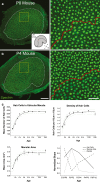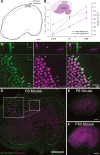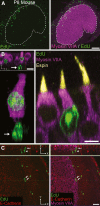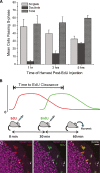Over half the hair cells in the mouse utricle first appear after birth, with significant numbers originating from early postnatal mitotic production in peripheral and striolar growth zones
- PMID: 22752453
- PMCID: PMC3441952
- DOI: 10.1007/s10162-012-0337-0
Over half the hair cells in the mouse utricle first appear after birth, with significant numbers originating from early postnatal mitotic production in peripheral and striolar growth zones
Abstract
Many non-mammalian vertebrates produce hair cells throughout life and recover from hearing and balance deficits through regeneration. In contrast, embryonic production of hair cells declines sharply in mammals where deficits from hair cell losses are typically permanent. Hair cell density estimates recently suggested that the vestibular organs of mice continue to add hair cells after birth, so we undertook comprehensive counting in murine utricles at different ages. The counts show that 51% of the hair cells in adults arise during the 2 weeks after birth. Immature hair cells are most common near the neonatal macula's peripheral edge and striola, where anti-Ki-67 labels cycling nuclei in zones that appear to contain niches for supporting-cell-like stem cells. In vivo lineage tracing in a novel reporter mouse where tamoxifen-inducible supporting cell-specific Cre expression switched tdTomato fluorescence to eGFP fluorescence showed that proteolipid-protein-1-expressing supporting cells are an important source of the new hair cells. To assess the contributions of postnatal cell divisions, we gave mice an injection of BrdU or EdU on the day of birth. The labels were restricted to supporting cells 1 day later, but by 12 days, 31% of the labeled nuclei were in myosin-VIIA-positive hair cells. Thus, hair cell populations in neonatal mouse utricles grow appreciably through two processes: the progressive differentiation of cells generated before birth and the differentiation of new cells arising from divisions of progenitors that progress through S phase soon after birth. Subsequent declines in these processes coincide with maturational changes that appear unique to mammalian supporting cells.
Figures









References
-
- Ahmed ZM, Goodyear R, Riazuddin S, Lagziel A, Legan PK, Behra M, Burgess SM, Lilley KS, Wilcox ER, Griffith AJ, Frolenkov GI, Belyantseva IA, Richardson GP, Friedman TB. The tip-link antigen, a protein associated with the transduction complex of sensory hair cells, is protocadherin-15. J Neurosci. 2006;26:7022–7034. doi: 10.1523/JNEUROSCI.1163-06.2006. - DOI - PMC - PubMed
Publication types
MeSH terms
Grants and funding
LinkOut - more resources
Full Text Sources
Other Literature Sources
Research Materials

